
 Goals of this Module
Goals of this Module
- Finding ways to positively improve our working environment;
- which can make a big difference to everyone’s mental health;
- Understanding what we can control and influence within our environments;
- Reducing stigma and making mental health a subject that we are happy to talk about.
We spend a great deal of time living together in this environment and we can all positively influence the mental wellbeing of ourselves and others.
In this module we will look at how we can do this. How we can help ourselves and each other and make the environment in which we live and work more positive and supportive.
We already identified in Module 1 the positive and negative influencers on our state of mental health. The aim is to increase the positive influencers and decrease the negative influencers.

Of course, we can’t change everything, but it is important to identify:
- Those factors we do have the power to control – we can directly manage and control them
- Those factors which we may not have personal control over but which we have the opportunity to influence
- Those factors which are out of our control or influence

In your own time on the sheet on the last page of this work book think about the things you can control and those you can influence in your life and think about the actions you can take to change these to improve your state of mental health.
Most importantly, identify those factors over which you have no control or influence. These are the things that it is not worth expending your emotional energy on – you can’t change them, no matter how worried or concerned you are about them. However, what you can do is control your reactions towards them.
Exercises
Reviewing our positive and negative influencers
Revisit exercises 1 and 2 in Module 1.
Exercise 1
Exercise 2

Make a plan together of:
- three things you can all do to positively influence your environment – increase the positives
- three things you can do to reduce negative influences on your environment – decrease the negatives
Exercise 3

Stigma

From these modules you have realised that:
- We all have a state of mental health;
- It is something that we can manage with tools and resources but also by reaching out to all the help and support available;
- It is not a weakness to struggle or to become ill, we are all normal human beings and we are all susceptible at times;
- By reaching out, and learning from others and experiences, we grow as human beings.
“Mental illness is nothing to be ashamed of, but stigma and bias shame us all” – Bill Clinton
One of the major issues that we experience in talking about our mental health is stigma. Stigma is defined as a “mark of disgrace that sets a person apart from others”, which is a wrong thing to do. It is as if we are building walls around them.
As we have discovered, we all have a state of mental health, all of us, everyone. We are not separate from everyone else, we are part of society, crews, families, the whole human race.
Stigma - Walls

Q: What can YOU do to stop stigma?
Q: What can WE do to stop stigma?

You have now finished the Mental Health introductory modules:
Q: In your group please discuss:
- What are the topics you found useful?
- Do you feel more confident in helping a colleague who you think may be struggling?
- What would you like to learn more about?
- What things will make the biggest difference to your own and your colleagues' state of mental health?

What can I control or Influence
Use this to start looking at those things in your life which you could change.
Identify what the issue is whether you can control, influence or whether it is out of your control.
If you can control or influence it, start thinking of the action steps you can take.
|
What is the issue |
Can I control it or influence it, or is it out of my control? |
Action plan |
|
e.g. personal spending |
I can control it |
Set myself a monthly budget |
|
|
|
|
|
|
|
|
|
|
|
|
|
|
|
|
|
|
|
